Hey there, nature lovers!
Are you ready to discover the remarkable wonders of Montana’s stunning landscapes? Now, I know what you’re thinking. How can a tree command such reverence and admiration?
Well, the Ponderosa Pine is no ordinary tree. With its towering presence, reaching heights of up to 200 feet tall and boasting trunks that can stretch up to 6 feet in diameter, it’s hard not to feel a sense of awe when you stand in its shadow.
But perhaps what truly sets the Montana State Tree apart is its versatility.
The Ponderosa Pine has been a cornerstone of Montana’s history, serving as a vital resource for commercial timber, railroad ties, and even telegraph poles.
What’s even more interesting is that the Ponderosa Pine self-prunes!
So, whether you’re a nature enthusiast or simply someone seeking solace in the embrace of Montana’s wild wonders, join me on this adventure to unravel the captivating story of the Ponderosa Pine.
- Related article: State of Montana Icons
Get ready to marvel at its beauty, unlock its hidden secrets, and forge an everlasting connection with one of nature’s most magnificent creations.
Montana State Tree
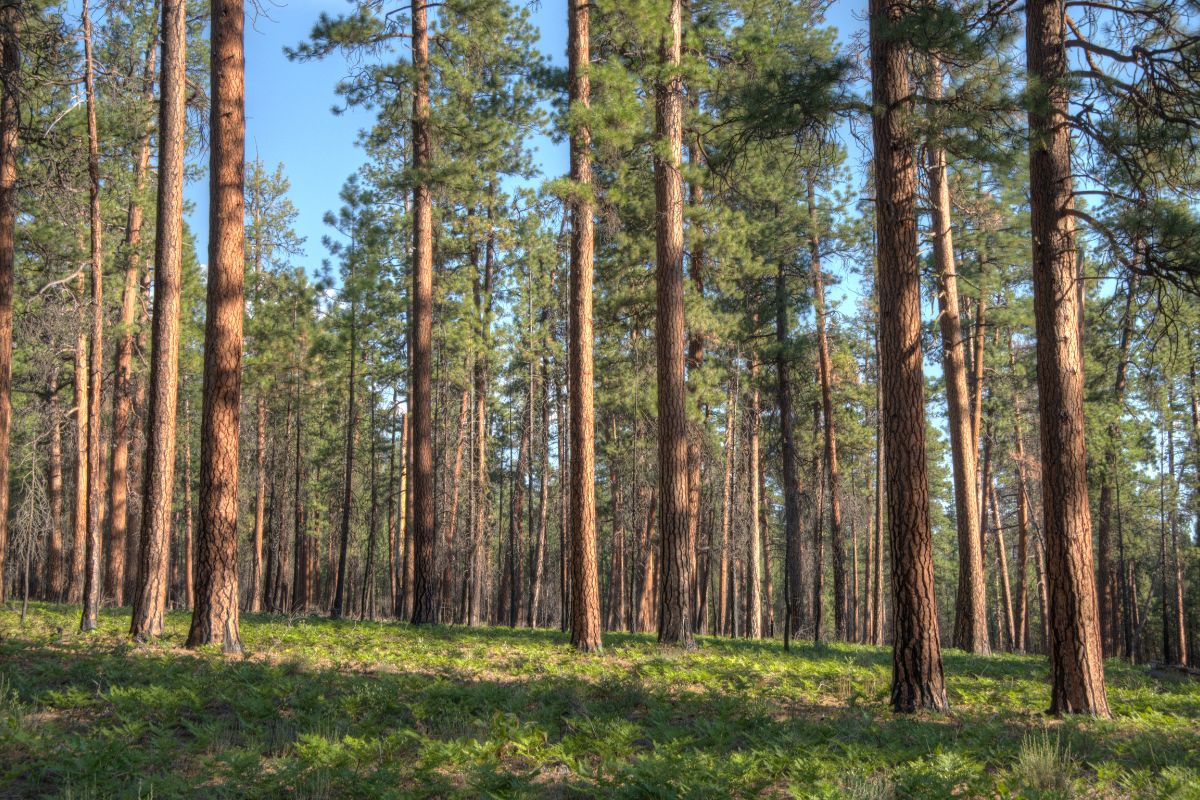
The Ponderosa Pine, the majestic symbol of Montana’s wild beauty. Was there ever a tree more fitting to represent this rugged state? I think not.
It stands tall and proud, with branches stretching outwards as if to embrace the vast expanse of land that is Montana.
But this towering wonder is more than just an impressive sight. Its importance runs deep, both in history and in the present day.
The logging and processing of Ponderosa Pine or Pinus ponderosa have contributed to Montana’s economy, providing jobs and revenue for the timber industry. Its wood is highly sought after for construction, furniture-making, and a myriad of other wood products.
It’s a tree that works hard.
And speaking of hard work, let’s talk about the many uses of this versatile tree today.
- Rehabilitating Landscapes – The Ponderosa Pine plays a crucial role in restoring damaged landscapes by providing cover and erosion control on rehabilitated sites. Its resilient nature aids in the rehabilitation process, giving a helping hand to Mother Nature.
- Building Marvels – It is a top choice in construction, known for crafting robust buildings, beautiful windows, and dependable panel doors due to its impressive strength and durability, making it a staple in the industry.
- Wildlife Haven – The Montana State Tree creates a thriving ecosystem hub, attracting creatures like Red-winged blackbirds, Chickadees, and Clark’s nutcrackers, who find sustenance and use its branches as nesting material, embraced by a variety of wildlife.
- Aesthetically Pleasing – Aside from its practical advantages, the Ponderosa Pine’s lush green color and delightful aroma make it a popular choice for ornamental plantings, extending its presence far beyond its natural range, and captivating the senses.
- Enhancing Open Spaces – As travelers journey along forested highways, the tree’s majestic presence as a border adds grandeur and enhances the scenic beauty of open spaces, leaving them in awe of its beauty.
But wait, there’s more! This tree has a multitude of hidden talents.
Did you know that its sap is used as glue and a source of turpentine oils? Or that artificial vanilla is made from its bark?
And here’s a fun fact: the Ponderosa Pine is also a source of pyrone, which is used as an FDA-approved flavoring in bread and cakes.
Oh, and if you’re in need of chewing gum or a natural antiseptic or expectorant, look no further than the Ponderosa Pine.
Now, let’s talk about the Ponderosa Pine’s many monikers.
It’s known by a multitude of alternative names such as the Yellow Pine or Western Pitch, each connecting it to different landscapes and regions.
Some call it the Bull Pine or Western Red, others, the Black jack pine. And if you find yourself in the Sierra Nevada, you might hear it being referred to as the Sierra brownbark pine.
But no matter what you call it, one thing remains clear: it’s the Montana State Tree, beloved by school children and cherished for its grace and resilience.
Along with Montana’s state flower, the Ponderosa Pine is a true embodiment of Big Sky Country’s wild spirit.
It’s a tree that has provided, inspired, and captivated. May it continue to grace our lands and tell tales of the untamed beauty that is Montana.
Montana State Tree Origins
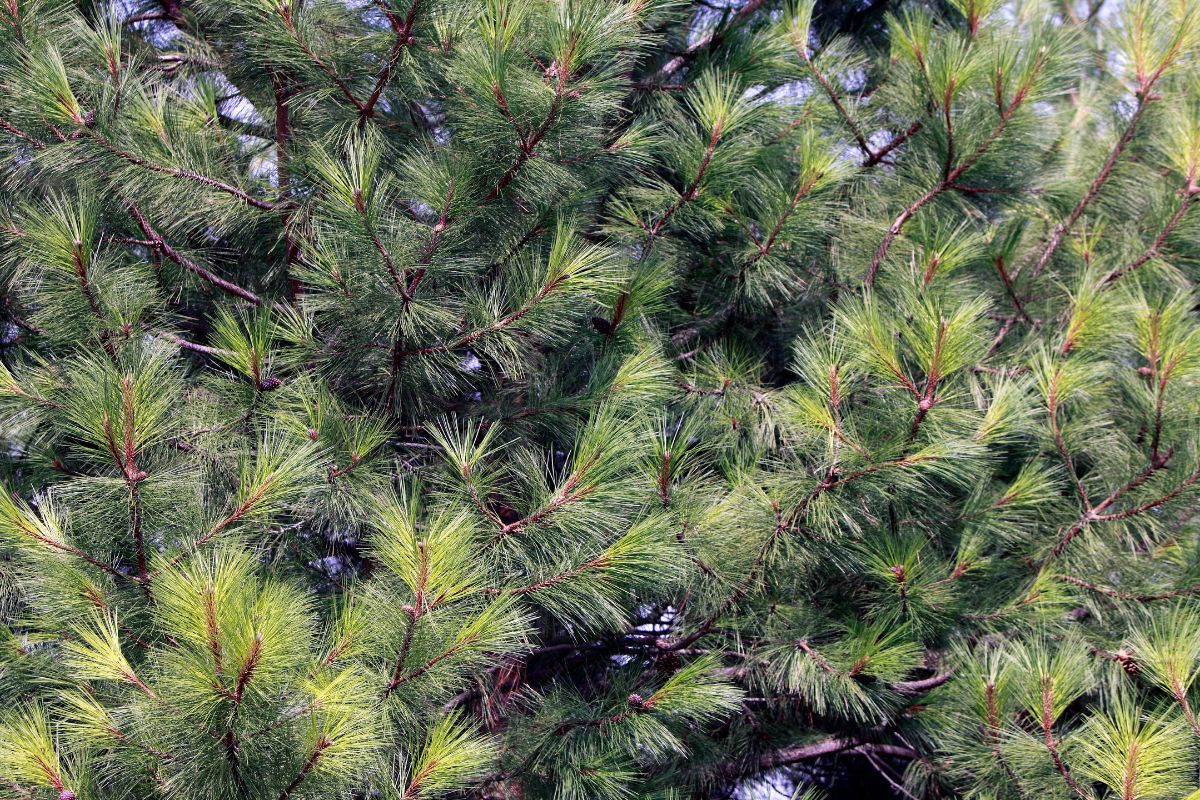
Have you ever wondered how this majestic tree earned such a prestigious title?
Back in 1908, the schoolchildren of Helena came together to decide which tree would best represent their beloved state of Montana.
They held a referendum, and the Ponderosa Pine easily outdistanced other Montana tree contenders like the Douglas fir, larch, and cottonwood to claim the title.
It was a choice made by the people, for the people.
But it wasn’t until 1949 that the Montana legislature made it official, declaring the Ponderosa Pine as the state tree.
This decision was greatly influenced by various advocacy groups, including The Montana Federation of Garden Clubs, who tirelessly campaigned on behalf of this magnificent tree.
Now let’s talk about the early uses of the Ponderosa Pine, which played a vital role in the lives of Montana’s early inhabitants:
- Natural Medicine Cabinet – The Ponderosa Pine’s extracted pitch served as a versatile ointment, providing relief from sores, backaches, and rheumatism, and was even trusted as a soothing remedy for infants.
- Sweat Lodge Savior – Early inhabitants found solace and relief from muscular pain by using the Ponderosa Pine’s boughs in sweat lodges, and they harnessed the tree’s various parts to create decoctions for treating internal hemorrhaging and infusions for medicinal purposes, especially for children.
- Nourishing Survival – The Ponderosa Pine played a vital role in sustaining early communities as every part of the tree, from the pitch, seeds, cones, bark, and buds to the cambium, pollen, and needles, provided nourishment and contributed to healing ceremonies.
- Crafting Canoes – During the Lewis and Clark Expedition of 1804-1806, the explorers skillfully utilized the Ponderosa Pine’s logs to construct sturdy dugout canoes, crucial for their journey down the Clearwater River in Idaho.
- Winter Insulation – In Montana’s harsh winters, the Ponderosa Pine’s needles were ingeniously used as insulation for underground storage pits, effectively preserving essential supplies and safeguarding them during colder months.
All these historical uses of the Ponderosa Pine highlight its deep-rooted significance to Montana’s heritage and its close connection to the land.
It’s a tree that represents the spirit of the state, embodying its natural beauty and resilience. And that is why it was chosen as Montana’s official State Tree.
What Is a Ponderosa Pine?
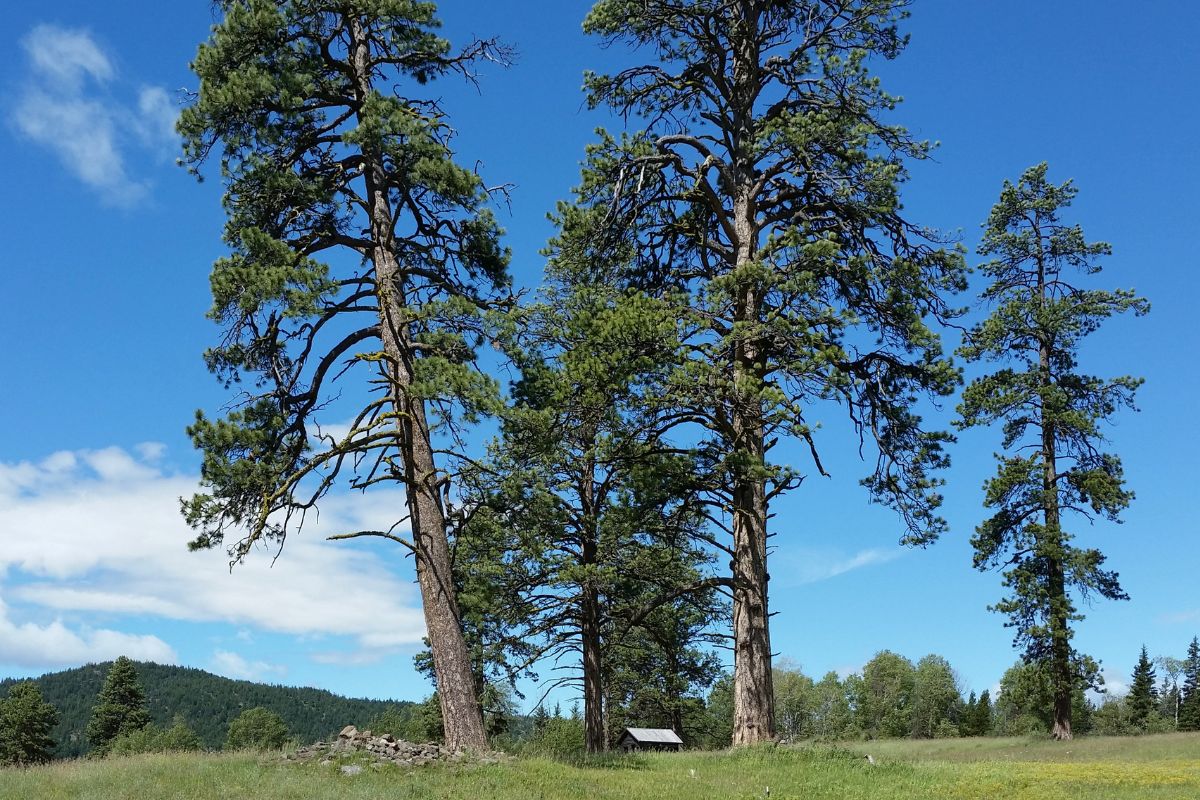
What is a Ponderosa Pine, you ask?
These majestic coniferous pine trees are native to the beautiful landscapes of Montana and Wyoming.
Standing tall and proud, a fully grown Ponderosa Pine reaches heights of 60 to 125 feet, a testament to its longevity of around 150 years.
As impressive as that may be, it’s the sheer girth, with a diameter of 20 to 30 inches, that truly captures the imagination.
Picture this: large trees reaching up to 65 meters, crowned with open branches that gracefully spread out in all directions.
But what distinguishes them goes beyond their mere size.
The bark of old Ponderosa Pines is a true work of art, thick, furrowed, and covered in scales reminiscent of a jigsaw puzzle. It’s a sight that never fails to leave me in awe.
And let’s not forget about the leaves, an intrinsic part of their charm. They sport a beautiful yellow-green hue, with clusters of 7 to 25-centimeter-long needles that gather at the ends of branches.
Oh, and those seed cones! Broadly ovoid and measuring 7 to 15 centimeters in length, they are a sight to behold. Thick scales, some even sporting a terminal and slender prickle, hold the seeds with their conspicuous wings.
It’s not only their physical appearance that makes them exceptional.
Ponderosa Pines are known for their self-pruning abilities. The lower branches gracefully shed as the tree grows, leaving behind a straight and sleek trunk. It’s a natural process that ensures the tree’s longevity and distinction.
Its towering stature, distinctive bark, and attractive cones are a testament to the remarkable wonders of Montana.
Where Can You Find Ponderosa Pine?
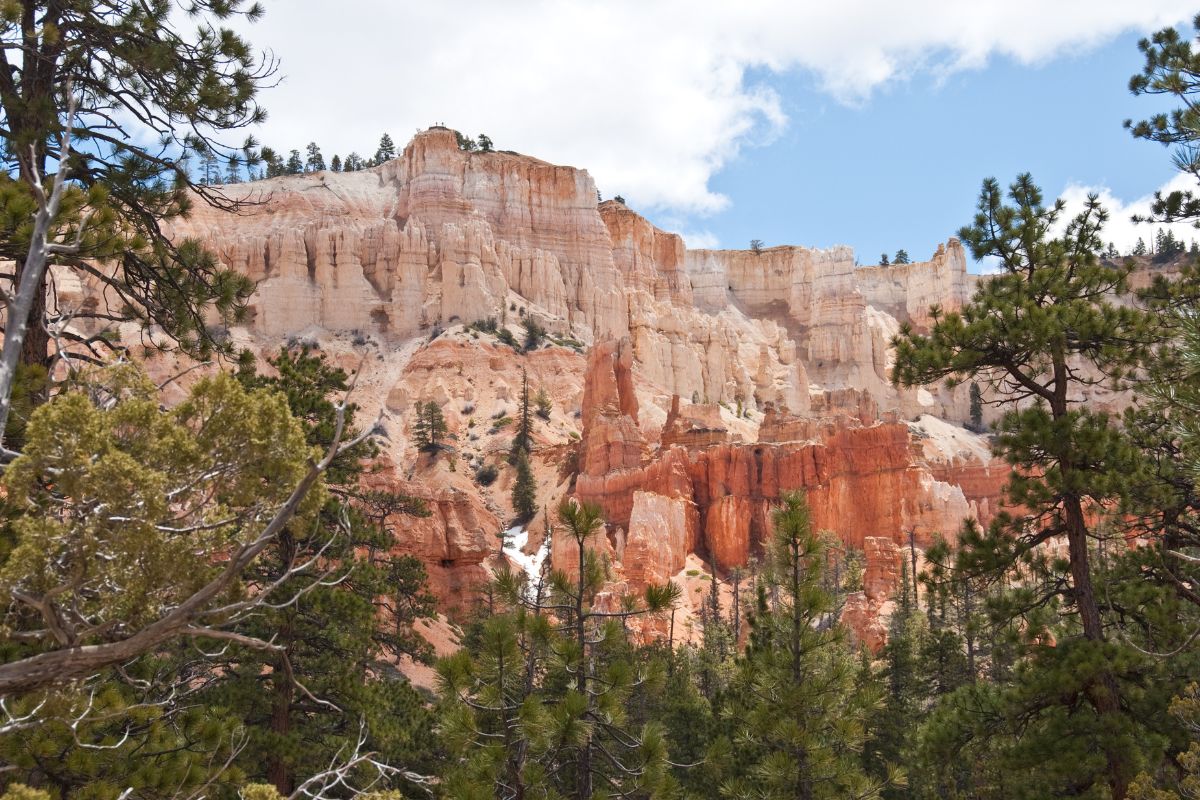
The Montana State Tree is widespread across the Western United States, including various regions of Montana.
The Ponderosa Pine can be found in distinct forest ranges throughout Montana as it grows best at elevations below 5,500 feet, provided there are other favorable site conditions.
Venture further into the Rocky Mountain Ponderosa Pine Woodland and Savanna, and you’ll discover a haven for these magnificent trees.
There is also an abundance of Pinus ponderosa in other notable areas such as the Great Plains Ponderosa Pine Woodland and Savanna.
In fact, these are where the Ponderosa Pine feels most at home, where it flourishes under proper cultivation. But where is the best spot to truly appreciate this splendid state tree?
Look no further than the Rocky Mountain Foothill Woodland-Steppe Transition, where you’ll find the most enchanting displays of Ponderosa Pines.
With its partially arid climate and ample sunlight, this region provides the perfect conditions for these trees to thrive.
From the Great Plains to the Rocky Mountains, this tree is a steadfast presence, adorning the slopes and flatlands with its striking silhouette. Montana, with its vast and varied landscapes, is a haven for the Ponderosa Pine.
Montana State Tree Fun Fact
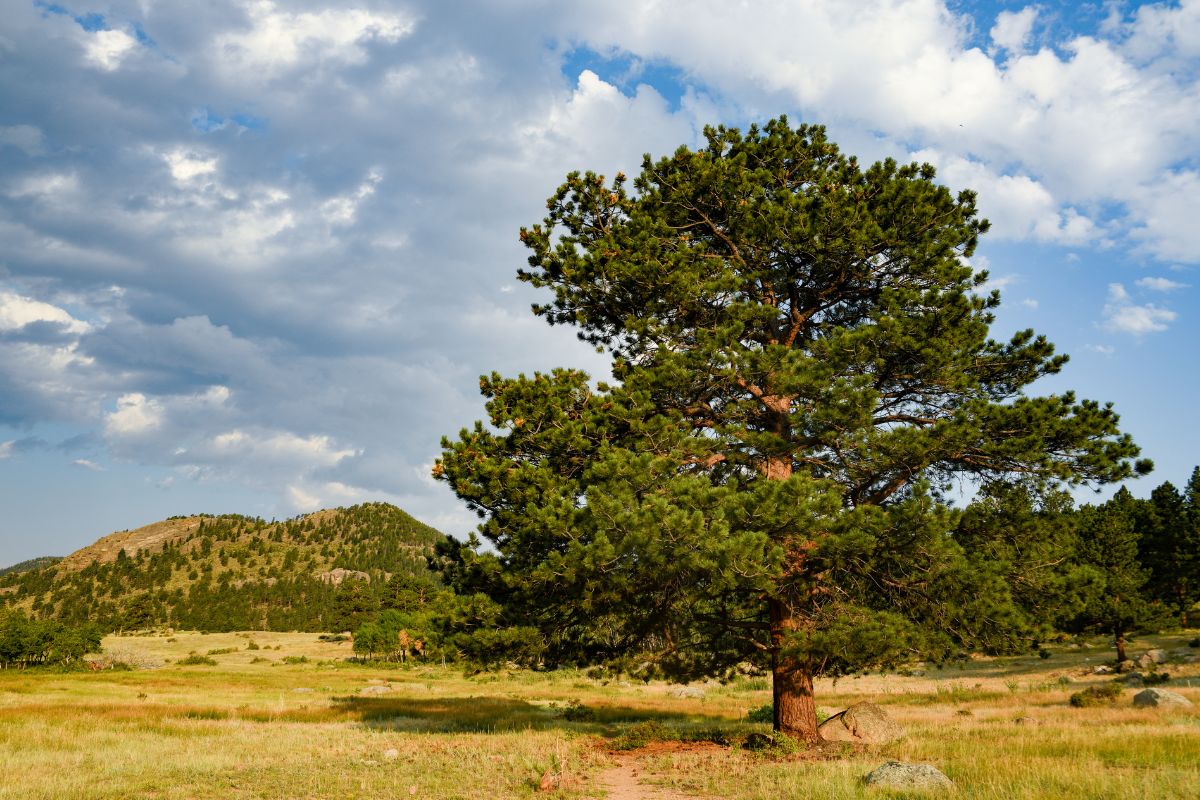
Did you know that the Montana State Tree has a fascinating history?
Back during the last ice age, the Ponderosa Pine and other tree species faced some tough times as the ice sheet advanced. The Montana State Tree had to make a choice: head south to Mexico or find refuge along the West Coast where the climate was warmer.4
As time went on, the Ponderosa Pines that made their home in Mexico and the ones along the West Coast started to evolve independently and developed some distinct characteristics.
The Ponderosa Pines in Mexico grew needles in groups of two, while their counterparts along the West Coast grew needles in groups of three.
But here’s where it gets really interesting.
As the ice sheets retreated and the climate became more favorable, the Ponderosa Pines began to spread east and north again.
Eventually, the Ponderosa Pines from Mexico and the West Coast met around the Continental Divide, on the Helena National Forest in Montana.2
This meeting zone is why the Ponderosa Pines in this area have needles in bunches of both two and three. It’s a unique characteristic that sets them apart from Ponderosa Pines in other regions.
So next time you come across a Ponderosa Pine in Montana, take a moment to appreciate its fascinating history and the journey it took during the last ice age.
It’s just another reason why the Montana State Tree is truly special.
The Montana State Tree: Ponderosa Pine Final Thoughts

These majestic giants, known as the Montana State Tree, have stood the test of time, evolving to thrive in diverse environments.
Standing tall and proud in the western part of the state, this remarkable yellow pine is a true testament to the beauty and strength of nature.
From the banks of Mexico to the rocky coasts of the West Coast, the Ponderosa Pines have forged their own paths, developing distinct characteristics along the way.
With its straight trunk and attractive cones, the tallest recorded for a Ponderosa Pine reaches heights of up to 232 feet and a diameter of over 8.5 feet. Its bark ranges in color from brown to orange, adding a warm and rustic charm to the landscape.
But it’s not just its aesthetic appeal that makes this tree remarkable.
The Ponderosa Pine has proven itself as a valuable source of commercial timber, utilized for everything from railroad ties to telegraph poles.
But its significance goes beyond economic considerations.
This species of pines has also been the subject of scientific study and conservation efforts, with detailed reports and extensive notes listing its various names and characteristics.
What is truly fascinating about the Ponderosa Pine is its ability to self-prune, shedding lower branches to create an uncluttered lower trunk.
This allows sunlight to penetrate the forest floor and promotes the growth of a diverse understory.
It’s a true example of nature’s innate balance and adaptability.
The Ponderosa Pine is not just a state tree; it is a symbol of the natural beauty and rich biodiversity found in Montana’s landscapes.
Let us embrace the awe-inspiring beauty and significance of these magnificent trees and ensure their continued existence for years to come.
The Montana State Tree: Ponderosa Pine FAQs
1. How Tall Is the Montana State Tree?
The Montana State Tree, also known as the Ponderosa Pine, is a true giant among us.
On average, it reaches maturity at a staggering height of 60 to 125 feet! And if you think that’s impressive, hold onto your hat, because its trunk can measure around 20 to 30 inches in diameter.
2. Why Is It Called Ponderosa Pine?
The name Ponderosa Pine refers to the large size and heavy wood attained by these trees.
The species name Ponderosa means “large, heavy, ponderous”, showcasing its majestic stature with a towering height, attractive cones, and deep furrows on its bark.
Their size and strength make them ideal for a range of applications, including Ponderosa timber for railroad ties and telegraph poles.
3. Where to Find the Ponderosa Pine in Montana?
You can find the Ponderosa Pine tree widespread across the Western United States, including in Montana.
It thrives in areas with a partially arid climate, in most of Northwest and Western Montana. This magnificent tree requires ample sunlight and typically grows in forests with plenty of space between trees.
Explore Montana further and give these other articles a read:
- https://mhs.mt.gov/education/docs/Footlocker/Symbols.pdf
- https://montanakids.com/facts_and_figures/state_symbols/State_Tree_Ponderosa_Pine.htm
- https://fieldguide.mt.gov/speciesDetail.aspx?elcode=%20PGPIN040S0
- https://www.fpl.fs.usda.gov/documnts/usda/amwood/254ponder.pdf
- https://www.fs.usda.gov/detail/hlcnf/landmanagement/resourcemanagement/?cid=stelprdb5378437
- https://www.nrcs.usda.gov/plantmaterials/mtpmctn10696.pdf
- https://www.ag.ndsu.edu/trees/handbook/th-3-169.pdf
- https://nfs.unl.edu/documents/communityforestry/PlantGuidePonderosaPine.pdf
- https://www.fs.usda.gov/wildflowers/kids/coloring/books/Wildflowers_of_Ponderosa_Pine_Forests.pdf
- https://ucanr.edu/sites/forestry/Ecology/Identification/Ponderosa_Pine_Pinus_ponderosa/

